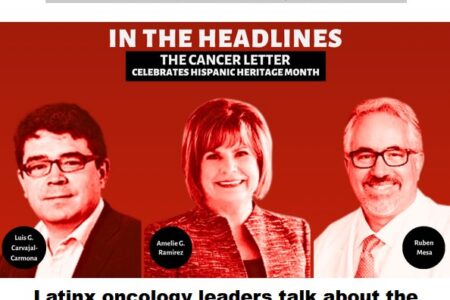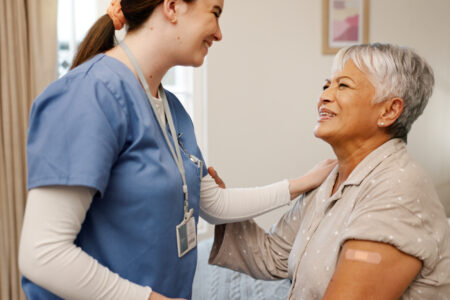
Share On Social!
This is part of the “Advancing the Science of Cancer in Latinos: 2022 Conference Proceedings,” which summarizes findings and discussions of the 2022 Advancing the Science of Cancer in Latinos Conference on Feb. 23-25, 2022, in San Antonio, Texas.
Transformative Strategies in Science and Access in the US
Dr. Edith A. Perez is the Serene M. and Frances C. Durling Professor of Medicine at the Mayo Clinic College of Medicine and the Chief Medical Officer at Bolt Biotherapeutics. Her presentation outlined strategies for health improvement as exemplified by important committees of the National Academies of Sciences, Engineering, and Medicine (NASEM) and Stand Up To Cancer (SU2C).

The NASEM initiative, which was requested by congress, focuses on improving the reflectivity of people in clinical trials and research to the US population. This work aims to identify policies and programs aimed at increasing participation, analyze the economic benefits of participation, highlight new programs designed to have the most positive impact on a lack of reflectivity, and identify factors that best predict which programs and interventions are replicable and scalable.
SU2C’s initiative, began in 2018, is committed to addressing the challenges of access to new treatments for all cancer patients. The committee seeks to change the health challenges landscape by supporting the reflectivity of people in clinical trials, research, and programs to the US population. In pursuit of these goals, the committee developed criteria for proposals within the context of SU2C, including three critical components: an indication of whether the research will address the populations expected to benefit from widespread use of newly developed treatments; patient recruitment and retention plans for including people in clinical trials as reflected in the US population; and a letter of support from the lead institution’s leader in community health issues.
Dr. Perez closed by emphasizing the feasibility of making a significant and meaningful impact. It is an achievable and noble goal to ensure all communities have access to new, more effective screening, diagnosis, and treatments. In this way, cancer risk can be decreased, and all persons diagnosed with cancer may become long-term survivors.
Advancing Precision Medicine Through Comprehensive Molecular Profiling
Dr. Yashira Negrón Abril is Medical Science Liaison at Caris Life Sciences. She began by discussing the transition in health care over recent years from the “one-size-fits-all” approach of traditional medicine, to precision medicine enabled by comprehensive molecular profiling. This profiling allows physicians to identify patients at high risk, select the most appropriate treatment options, and match patients to clinical trials.
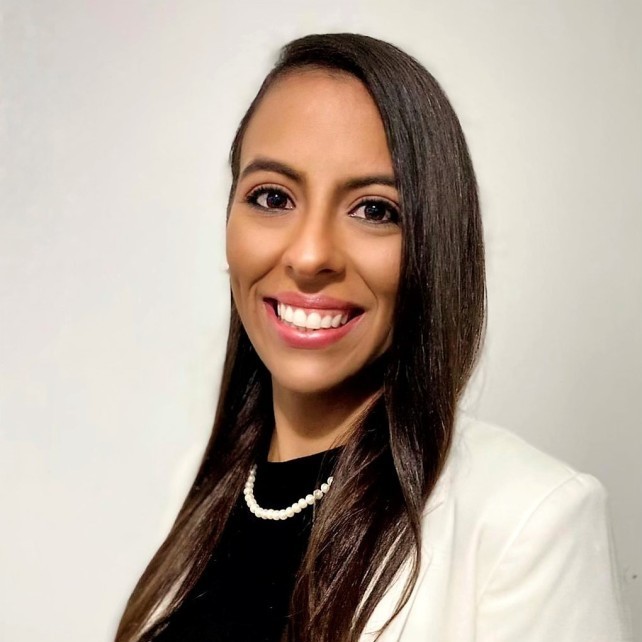
Caris Life Sciences is a molecular and diagnostic company that assesses DNA, RNA, and proteins for almost all cancer types to reveal a molecular blueprint that helps physicians and cancer patients make more precise and personalized treatment decisions. Over the past 10 years, Caris has gathered longitudinal clinical outcome data for over 275,000 patients, and more than 356,000 patients were tested in 2021 alone.
In order to build on this wealth of data, the Caris Precision Oncology Alliance (POA) was created, enabling physicians and researchers to optimize clinical care for cancer patients through scientific collaboration. POA members include over 59 leading cancer centers and universities from across the US, Europe, and Asia.
Dr. Negrón Abril closed by discussing POA’s newest healthcare council, which was recently established to guide and drive high impact research studies. To expand precision medicine’s reach, Dr. Negrón Abril stressed the need for access to comprehensive molecular profiling, as well as participation in both biomedical research and clinical trials that reflects the US population. All stakeholders must continue working together to address the challenges in cancer treatment, ultimately achieving health improvement across all populations.
How BMS is Addressing the Need for Clinical Trial Participation
Lorena Kuri is from Bristol-Myers Squibb (BMS). She began by discussing the need for clinical trial participation that reflects the US population. In the US, four out of ten people are non-White, but only one out of ten clinical trial participants are non-White. Bristol-Myers Squibb is addressing this in its Clinical Trials Program.

Through this program, BMS is committed to doing its part to help ensure patients have a fair opportunity to achieve optimal health outcomes. To achieve this goal, the program seeks to improve recruitment of the participant population so that clinical trials become more reflective of real-world demographics. This program is process-driven, with permanent change as the ultimate goal. The program aims at having 25% of the US sites participating in new BMS clinical trials located in certain areas.
Dr. Kuri closed by outlining the Clinical Trials Program’s focuses for the future: ensuring that processes are aligned with external commitments when selecting US sites and investigators; reducing practical obstacles to clinical trial participation; strictly adhering to FDA guidelines; tracking performance and ensuring commitments are maintained; incorporating community groups, partnerships, and external thought partners; and committing to internal and external training. These goals will propel BMS on its path toward a better clinical trials program.
Increasing Access to Cancer Screening: Working with Communities in Texas
Dr. Michael del Aguila is Senior Director & Head of Population Health Sciences at GRAIL, a healthcare company focused on saving lives and improving health by pioneering new technologies for early cancer detection. Dr. del Aguila began by emphasizing the importance of early detection for survival, explaining that cancer patients show an 89% 5-year survival rate when diagnosed early, compared to 21% when diagnosed after metastasis. Furthermore, although the United States Preventive Services Task Force (USPSTF) has recommended screening for five cancers, 68% of cancer deaths are due to cancers without screening recommendations. Early detection therefore represents an important area in which GRAIL may make impactful change.
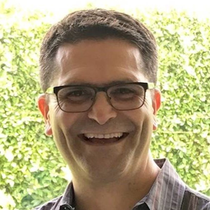
Because tumors shed nucleic acids carrying cancer-specific information into the blood and other bodily fluids, GRAIL developed a proprietary methylation-based technology for cancer detection. Selected for development based on the results of the first sub-study of the Circulating Cell-free Genome Atlas study (CCGA), GRAIL has since refined and commercially launched this technology as an investigational, multi-cancer, early detection Test called Galleri. The test was launched in June of 2021, and has a 44% positive predictive value, 0.5% false positive rate, and an 89% rate of cancer signal origin predicted correctly, with more than 50 cancer types detected.
Dr. del Aguila ended his talk by discussing the Reflection study from the Population Health Sciences program at GRAIL. This study is designed to distribute Galleri to 35,000 patients. The Galleri test and the Reflection study represent a shift in approach for cancer screening: instead of screening for an individual cancer, individuals are being screened for multiple cancers. This shift could have a far-reaching impact on the cancer survival landscape.
Increasing Participation in Clinical Research
Dr. Veronica Sandoval is a representative with Genentech. Genentech’s mission is to deliver scientific innovations that drive outcomes for people, patients, businesses, and communities. One of Genentech’s main pillars is advancing research with participants that reflects the US population and health improvement, meaning that by 2025, all molecule teams will include population-specific assessments and action plans.
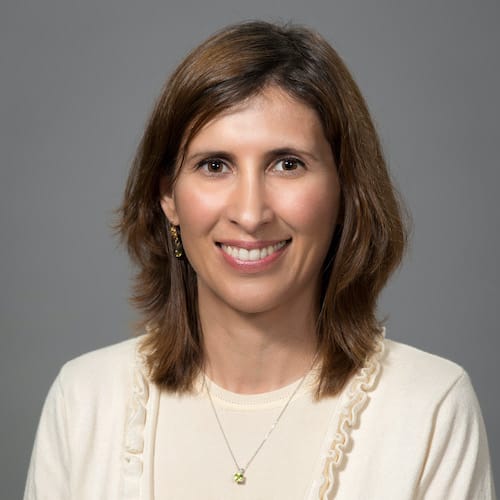
The Latino community makes up approximately 17% of the US population, but only 1-8% of clinical trial participants. Furthermore, 90% of the genomic material available to scientists is of European ancestry. To address this, Genentech launched the AIR Site Alliance, a pilot partnership with four key sites: City of Hope in Los Angeles, the O’Neil Comprehensive Cancer Center in Birmingham, West Cancer Center in Memphis, and Mays Cancer Center in San Antonio. Each of these centers has built trusting relationships with local communities and can help bridge the gap of clinical trials with participants that don’t reflect the US population.
Dr. Sandoval closed by discussing Genentech’s Innovation Fund, which is focused on investing in programs that prioritize research, care, and more that reflects the US population. In 2020, 40 programs received innovation grants from Genentech, six of which were in Texas. The partnerships represented by the Innovation Fund, as well as the AIR Site Alliance, represent collaboration between industry, payers, healthcare providers, patients, legislators, and more. It is these partnerships that will address challenges and improve health in the community.
By The Numbers
142
Percent
Expected rise in Latino cancer cases in coming years


